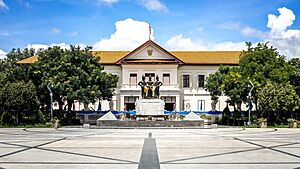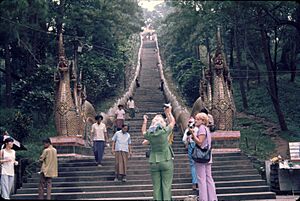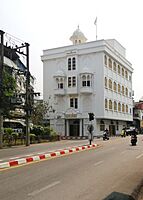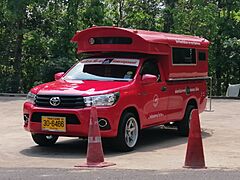Chiang Mai facts for kids
Quick facts for kids
Chiang Mai
เชียงใหม่
ᨩ᩠ᨿᨦᩉ᩠ᨾᩲ᩵
|
||
|---|---|---|
|
City municipality
|
||
| Chiang Mai City Municipality เทศบาลนครเชียงใหม่ |
||
|
From top, left to right: View of Chiang Mai City, Wat Phra Singh, Tha Phae Gate, Wat Phra That Doi Suthep, Wat Chiang Man
|
||
|
||
| Country | ||
| Province | ||
| Amphoe | Mueang Chiang Mai | |
| City municipality |
29 March 1935 | |
| Districts |
4
Nakornping District
Kawila District Mengrai District Sriwichai District |
|
| Government | ||
| • Type | City municipality | |
| Area | ||
| • City municipality | 40.216 km2 (15.5274844 sq mi) | |
| • Urban | 405 km2 (156.371 sq mi) | |
| Area rank | 11th | |
| Elevation | 310 m (1,020 ft) | |
| Population
(2019)
|
||
| • City municipality | 127,240 (Municipal area) |
|
| • Rank | 8th | |
| • Density | 3,164/km2 (8,190/sq mi) | |
| • Urban
(2022)
|
1,198,000 (Principal city area/เขตเมือง) | |
| • Urban density | 2,958/km2 (7,660/sq mi) | |
| • Metro | (To be announced) | |
| Time zone | UTC+07:00 (ICT) | |
| Postal code |
50000
|
|
| Calling code | 053 & 054 | |
| Airport | Chiang Mai International Airport | |
| Inter-city rail | Northern Line | |
Chiang Mai is the biggest city in northern Thailand. It's the capital of Chiang Mai province and the second largest city in Thailand overall. It's about 700 kilometers (435 miles) north of Bangkok, located in a mountainous area called the Thai highlands. As of 2022, about 1.2 million people live here, which is more than half of Chiang Mai province's total population.
Chiang Mai means "new city" in Thai. It was founded in 1296 to be the new capital of the ancient kingdom of Lan Na, taking over from the old capital, Chiang Rai. The city's location near the Ping River and important trade routes made it a very important place long ago.
The official city area of Chiang Mai is quite small, covering only about 40.2 square kilometers (15.5 square miles) in the city center, with a population of about 127,000 people. However, the city has grown a lot! Its urban area now spreads into several nearby districts like Hang Dong and Mae Rim. This larger urban area has over a million residents.
The city is divided into four main parts: Nakhon Ping, Sriwichai, Mengrai, and Kawila. Most of the city, including the old city walls, is on the west side of the Ping River.
Contents
- A Look Back: Chiang Mai's History
- Who Lives in Chiang Mai?
- Chiang Mai's Location and Nature
- How Chiang Mai is Growing
- Visiting Chiang Mai
- Culture and Celebrations
- Air Quality Concerns
- Amazing National Parks
- Fun Things to Do
- Getting Around Chiang Mai
- Famous People from Chiang Mai
- International Connections
- Images for kids
- See also
A Look Back: Chiang Mai's History
King Mangrai started Chiang Mai in 1296. It was built on a spot that the Lawa people called Wiang Nopburi.
Chiang Mai became the capital of the Lan Na kingdom. Later, another king, Pha Yu, made the city bigger and stronger. He also built Wat Phra Singh to honor his father. Over time, the Lan Na kingdom became less powerful, and Chiang Mai was taken over by the Taungoo in 1556.
In 1774, Chiang Mai officially became part of the Thonburi Kingdom. This happened after King Taksin helped drive out the Taungoo Bamar. Because of more fighting, Chiang Mai was actually empty between 1776 and 1791.
The modern city government started in 1915. It became a "city municipality" on March 29, 1935. The city area was first 17.5 square kilometers, then grew to 40.2 square kilometers in 1983.
In 2014, TripAdvisor listed Chiang Mai as one of the "25 Best Destinations in the World." Also, the idol group CGM48 was formed here!
What Does the City Emblem Mean?
The city's emblem shows the famous stupa (a dome-shaped structure) at Wat Phra That Doi Suthep. Below it, there are clouds, which show the nice weather in the northern Thai mountains. You can also see a nāga, a mythical snake believed to be the source of the Ping River. Rice stalks are also on the emblem, showing how fertile the land is.
Who Lives in Chiang Mai?
Since the city area was last made bigger in 1983, the population has grown a lot. The official city area has about 127,000 people. But the larger urban area, which includes many surrounding places, has grown to over 1.19 million people by 2022. This makes Chiang Mai the second largest city in Thailand, after Bangkok.
The city's urban area now reaches into many nearby districts. This includes Mae Rim in the north, San Kamphaeng in the east, Hang Dong in the south, and Suthep in the west. This big area is about 405 square kilometers (156 square miles).
Because of how the population is counted, the real number of people living in Chiang Mai, including those from other parts of Thailand and other countries, might be as high as 1.5 million.
Chiang Mai's Location and Nature
Chiang Mai is in a valley, surrounded by mountains in the Thai highlands. It's about 300 meters (1,000 feet) above sea level. The city center is west of the Ping River, which flows into the Chao Phraya River. To the west of Chiang Mai, you can see the Thanon Thong Chai Range mountains, with Doi Suthep mountain rising high above the city at 1,676 meters (5,499 feet).
Green Spaces and Parks
Chiang Mai has several parks and green areas. Buak Hat Public Park is a popular park in the southwest part of the old city. Right across from it is Kanchanaphisek Park, which has parts of the old city walls. Other larger parks include Lanna Rama 9 Park in the north and Ang Keaw Reservoir near Chiang Mai University.
Weather in Chiang Mai
Chiang Mai has a tropical climate, meaning it's warm to hot all year. However, during the dry season, nights can be cooler. The hottest temperature ever recorded was 42.5°C (108.5°F) in May 2016.
How Chiang Mai is Growing
In 2017, the government started a plan to make Chiang Mai a "smart city." This means using technology to improve life in the city. Chiang Mai was one of the first cities in Thailand to try this "smart city" idea. It involves collecting information from sensors, traffic updates, and social media to help city managers and citizens.
Smart Transportation
In 2018, Chiang Mai launched "Mobike In," a bike-sharing app. About 500 smart bikes were placed around the city for locals and tourists to use. You can find them at places like the Three Kings monument and Tha Pae Gate. This project encourages people to use bikes instead of cars and supports eco-tourism.
Smart Farming
Funding has been given to Maejo University in Chiang Mai to develop smart systems for farming. This includes wireless sensors to help farmers water their crops better and use less water. They are also working on agricultural drones that can spray fertilizers and pesticides, which could save money. These drones might also help detect forest fires and smoke pollution.
Smart Healthcare
Chiang Mai is also using technology to become a better place for medical tourism. Experts from IBM helped the city plan how to use technology to improve hospitals and medical services. For example, hospitals could use tracking systems to find patients and equipment faster. Electronic medical records could also help link all medical services, including traditional Thai medicine. The goal is to make Chiang Mai a top place for medical care, especially for international visitors.
Smart Tourism
A mobile app has been developed that uses augmented reality to show historical sites in Chiang Mai. This helps promote Chiang Mai as a world heritage city.
Visiting Chiang Mai
Chiang Mai is a very popular place for tourists. In 2013, it had over 14 million visitors. By 2016, tourist numbers were expected to grow to 9.1 million. Many visitors come from China, making up about 30% of international arrivals. Tourism has grown a lot since 2011, partly because of the city's beautiful scenery, nice weather, and rich history. Chiang Mai has many hotels, and Chiang Mai International Airport is Thailand's fourth busiest airport.
The city also wants to attract more business events and conferences.
Famous Buddhist Temples
Chiang Mai has 117 Buddhist temples, called "wat" in Thai, in its main district. Some of the most famous ones include:
- Wat Phra That Doi Suthep: The city's most famous temple, located on Doi Suthep mountain. It's high up at 1,073 meters (3,520 feet).
- Wat Chiang Man: The oldest temple in Chiang Mai, built in the 13th century. King Mengrai lived here when the city was being built. It has two important Buddha statues made of marble and crystal.
- Wat Phra Singh: Inside the city walls, this temple dates back to 1345. It's a great example of classic Northern Thai architecture and houses the highly respected Phra Singh Buddha.
- Wat Chedi Luang: Founded in 1401, this temple has a huge Lanna-style stupa. An earthquake damaged it in the 16th century, so only about two-thirds of it remains.
- Wat Umong: A forest and cave temple located in the foothills west of the city, near Chiang Mai University. It's known for its "fasting Buddha" statue.
- Wat Suan Dok: A 14th-century temple just west of the old city wall. It's also home to a Buddhist university where monks study.
There are also many ruined temples around the city. Often, only the main brick stupa remains, while other buildings have disappeared over time.
Museums to Explore
Chiang Mai has several museums where you can learn about art and the local Lanna culture:
- Chiang Mai City Arts and Cultural Center
- Chiang Mai National Museum: Shows the history of the region and the Lan Na Kingdom.
- Highland People Discovery Museum: Explores the history of the local mountain tribes.
- MAIIAM Contemporary Art Museum: A modern art museum that opened in 2016.
Other Places of Worship
-
The Hindu temple Dev Mandir
Chiang Mai has a diverse community with different religions. You can find:
- Christian churches, including the Sacred Heart Cathedral.
- Mosques for the Muslim community, some linked to Chinese Muslims and others to people from different backgrounds.
- Two gurdwaras (Sikh places of worship) for the Sikh community.
- The Hindu temple Dev Mandir for the Hindu community.
How Tourism Affects the City
While tourism brings many benefits, it also puts some pressure on the city. There's been a lot of unplanned building, and issues with air and water pollution, waste, and traffic. To help with this, the city is trying to encourage non-motorized transport like bikes. This helps reduce pollution and creates jobs.
Tourism has also helped local artists and craftspeople. More tourists mean more demand for traditional crafts, which encourages local artists to keep their skills alive. There are also opportunities for "agritourism," where farmers can earn extra income by letting visitors experience farm life and buy local products.
Culture and Celebrations
Chiang Mai is famous for its lively festivals:
- Loi Krathong: Held around November, people float beautiful rafts made of banana leaves with flowers and candles on the water. They also launch sky lanterns into the air. This is believed to get rid of troubles.
- Songkran: Celebrated in mid-April, this is the traditional Thai New Year. Chiang Mai is a very popular place for this festival, known for its citywide water fights, parades, and beauty contests.
- Chiang Mai Flower Festival: A three-day festival in early February when Chiang Mai's many beautiful flowers are in full bloom.
- Tam Bun Khan Dok: The Inthakhin (City Pillar) Festival, which lasts about 6-8 days.
Buddhism in Daily Life
Buddhist celebrations are important here. During Vesak, thousands of Buddhists walk up Doi Suthep mountain to the temple at the top after sunset. Makha Bucha Day is also celebrated at large temples with many people attending.
Languages Spoken
Most people in Chiang Mai speak Thai. However, many older residents also speak Northern Thai, also known as Lanna or Kham Mueang. The original script for this language, called Tai Tham alphabet, is mostly studied by scholars now. The language is usually written using the standard Thai alphabet.
Local Food
Khan tok is a traditional Lan Na Thai meal that has been enjoyed for centuries.
Air Quality Concerns
One ongoing issue in Chiang Mai is air pollution, which usually happens every year between December and April. This pollution comes from things like forest fires and burning crops. During these months, the air quality can be unhealthy, with tiny dust particles reaching levels higher than recommended.
To help with this, the city is promoting the use of non-motorized transport, like walking and biking. This helps reduce pollution from cars and also helps with traffic jams.
Amazing National Parks
Chiang Mai is close to beautiful national parks:
- Doi Inthanon National Park: Home to Doi Inthanon, Thailand's highest mountain. It's popular for its waterfalls, hiking trails, and cool weather at higher elevations.
- Doi Suthep–Pui National Park: This park starts right on the western edge of the city. The famous Wat Doi Suthep temple is located here.
- Pha Daeng National Park: Also known as Chiang Dao National Park, it includes Doi Chiang Dao mountain. Many tour companies offer treks here to explore the hills, forests, and visit local hill tribes like the Akha and Karen.
Fun Things to Do
Shopping
Chiang Mai has three large shopping malls: Central Chiang Mai Airport, Central Chiang Mai, and Maya Shopping Mall, where you can find many big brands.
For unique local items, visit the famous Night Bazaar, which sells arts and handicrafts. The night markets spread across many city blocks.
The most famous handicraft and food market is the Tha Phae Walking Street, or Chiang Mai Sunday Night Market. It opens every Sunday evening on Rachadamnoen Road, the main street in the old city, which is closed to cars. On Saturday evenings, there's another handicraft market along Wua Lai Road, known as Chiang Mai's silver street.
Other Attractions
- Chiang Mai Zoo: The oldest zoo in northern Thailand.
- Khlong Mae Kha: A canal area that has been beautifully decorated, similar to famous canals in Japan and South Korea.
Getting Around Chiang Mai
As more people live in Chiang Mai, traffic can get busy, especially during rush hour. People mostly use motorbikes and cars. For public transport, you can use tuk-tuks, songthaews (red pickup trucks with two rows of seats), buses, or rickshaws. New electric tuk-tuks were introduced in 2017.
Buses
Chiang Mai has bus stations that connect the city to other parts of Thailand. The Chang Puak Terminal serves places within Chiang Mai Province. The Chiang Mai Arcade bus terminal has buses to over 20 other cities, including Bangkok. Since December 2023, Chiang Mai also has a city bus system called RTC Chiang Mai City Bus, with three lines starting and ending at the airport.
Trains
The state railway runs 10 trains a day from Bangkok to Chiang Mai railway station. Most trips are overnight and take about 12-15 hours. Chiang Mai is the very end of the Thai railway system in the north.
There are also plans to build a light railway transit system in Chiang Mai. Construction might start in 2020 and finish by 2027. This system is expected to help a lot with traffic problems.
Airports
Chiang Mai International Airport is Thailand's fourth busiest airport. It has about 50 flights a day from Bangkok and also serves as a hub for flights to other northern cities like Chiang Rai. International flights connect Chiang Mai with other cities in Asia. There are plans to make the current airport bigger and even build a second airport.
Famous People from Chiang Mai
- Jongkolphan Kititharakul — a Thai badminton player
- Anucha Saengchart — a social media personality
- Thaksin Shinawatra — a former Thai Prime Minister
- Yingluck Shinawatra — a former Thai Prime Minister
- Rodjaraeg Wattanapanit — the first Thai winner of the International Women of Courage Award
International Connections
Chiang Mai has special agreements with other cities around the world, called "sister cities" and "friendship cities." This helps them share culture and ideas.
Sister Cities
- Uozu, Japan
- Saitama Prefecture, Japan
- Kunming, China
- Harbin, China
- Pyongyang, North Korea
- Da Lat, Vietnam
Friendship Cities
Images for kids
See also
 In Spanish: Chiang Mai para niños
In Spanish: Chiang Mai para niños










































